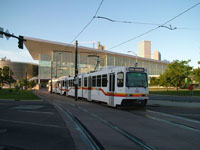 |
3-01. Downtown-bound 2-car train crosses Speer Blvd near Colfax Ave before entering the structure of the Convention Center. (17-June-2005, YM)
|
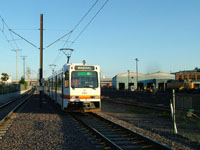 |
3-02. Outbound train of the D line destined to Mineral enters long segregated right-of-way of the Littleton Line, built via the corridor of the Southern Pacific Railroad. This train just left the 10th / Osage Station. Note the 50 mph traffic sign identical to those used on highways. (17-June-2005, YM)
|
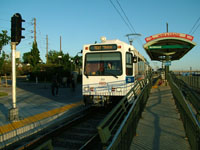 |
3-03a. Car 201 is the first of 34 new Siemens-Duewag SD100 high-floor articulated cars of the 200 series delivered prior to the opening of the new Southeast Extension. These cars are practically identical to the cars of the 100 series, the only novelty being sliding plug bi-doors as opposed to double-folding doors. Empty light rail vehicles will run intermittently to complete testing, each new vehicle must operate successfully for 1,500 miles before being put into service. Car 201 stops at the 10th / Osage Station on its passenger-free journey to downtown. (17-June-2005, YM)
|
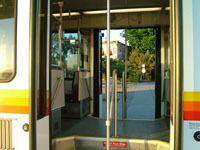 |
3-03b. All stations along the Littleton alignment have similar platform arrangement: as the freight railroad runs on the western side of the light rail line, all station exits face east through the inbound platform on the eastern side, while the outbound platform is sandwiched between the tracks. It means that inbound trains have platforms on both sides. To avoid confusion among passengers, all trains simply open doors on both sides. The famous Buckhorn Exchange Restaurant next to the 10th /Osage Station is visible on the other side of the train. This is the oldest restaurant in Colorado (opened 1883), decorated by some 500-odd pieces of taxidermy on the walls, and such items as elk, steaks, pheasant, grouse, and buffalo on the menu. (17-June-2005, YM)
|
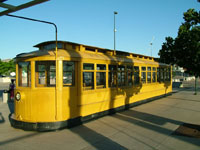 |
3-04a. An old Denver streetcar is converted into the waiting pavilion at the I-25 / Broadway Station, the farthest point of the line upon its initial opening on October 7, 1994. (17-June-2005, YM)
|
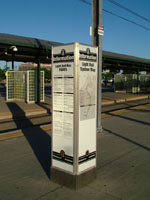 |
3-04b. A standard information kiosk at the I-25 / Broadway Station. (17-June-2005, YM)
|
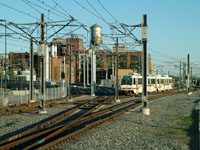 |
3-05. Two-car train serving the D line crosses through the junction south of the I-25 / Broadway Station, as it returns from Littleton / Mineral. Tracks leading eastward (viewer's left) belong to the newest Southeast Lines extension, which will actually have 2 branches: to Nine Miles and to Lincoln Ave. These lines are scheduled to open in late 2006. (17-June-2005, YM)
|
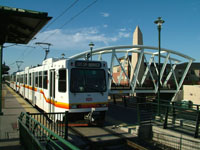 |
3-06a. Northbound D train stops at the Englewood Station. (17-June-2005, YM)
|
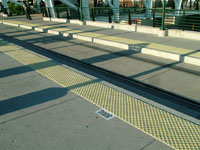 |
3-06b. The sign in the platform identifying where passengers are to expect a door to stop, which happens to be rather a seat-grabbing-assistance feature as opposed to a crowd-control measure. (17-June-2005, YM)
|
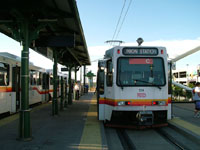 |
3-06c. Southbound D train and northbound C train stop simultaneously at the Englewood Station. Inbound trains open doors on both sides. Train on the right did manage to align against the 'DOOR' signs. Train on the left missed them completely. If handicapped passengers are present, trains pull all the way to the wheelchair access ramp. Otherwise, in most cases operators of shorter 2-car trains don't bother to pull up to the ramp (note a shadow of the C train in the background that ends ahead of the ramp). (17-June-2005, YM)
|
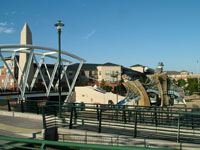 |
3-07a. Pseudo-urban fakery of downtown Englewood as seeing from the light rail station. Note the local Englewoodian version of the Brooklyn Bridge. (17-June-2005, YM)
|
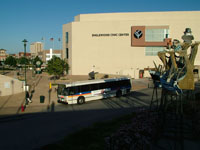 |
3-07b. Connecting bus awaits passengers exiting the light rail station in downtown Englewood. (17-June-2005, YM)
|
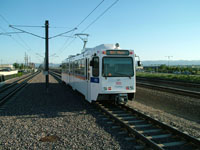 |
3-08. Test train 201 continues to Littleton / Mineral, as it is photographed just south of the Englewood. (17-June-2005, YM)
|
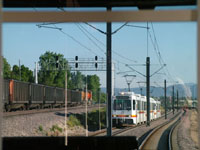 |
3-09. Northbound 3-car train heads to the depot after completing its last trip to Littleton / Mineral at the end of evening rush hour. The Southern Pacific freight train rumbles on in the opposing direction, helplessly outrun by the southbound light rail train this photo is taken from. Halfway between the Littleton / Downtown and the Littleton / Mineral stations the light rail line hops over to the western side of the freight railroad right-of-way. (17-June-2005, YM)
|
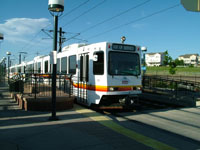 |
3-10a. Upon unloading passengers at the last Littleton / Mineral Station, this three car train continues on into the layover track. The sign is changed to 'out of service', as having completed its duties for the day, this train will now proceed to depot. (17-June-2005, YM)
|
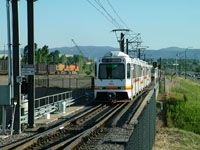 |
3-11. The same train pulls into the layover track for a turn-a-round. The Southern Pacific freight train catches up with us. The other light rail train sits at the stub end, yielding to the out-of-service train and ready to enter service as soon as it clears the way. Note a scary speed restriction at the switch: not 10 mph, not 15, but specifically 13 mph. (17-June-2005, YM)
|
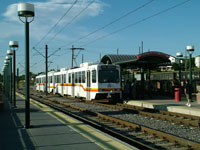 |
3-10b. The second train pulls out of the layover track and enters service on the D line. In this photo it loads passengers as it awaits its scheduled departure to Denver. (17-June-2005, YM)
|
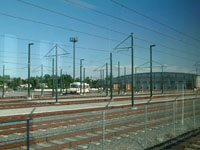 |
3-12a. One of two rail yards along the Littleton Line during the evening rush hour. (17-June-2005, YM)
|
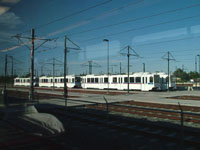 |
3-12b. Some of 34 brand new Siemens-Duewag SD100 trams of the 200 series sit in the rail yard next to the Littleton Line, waiting to be tested. (17-June-2005, YM)
|


















